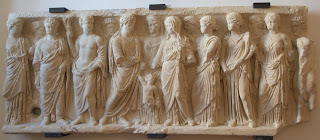Orvieto is truly a hill town in Umbria, next to Tuscany.
Built on top of a lonely butte, it is completely limited in size by the sheer
cliffs that rise up to the top of the butte on each side. As a nice change from
the other hill towns we have visited, this site is also basically flat. It does
slope a bit, but there are none of those steep climbs one finds in most of
these hill towns. Fortunately, one does not have to hike up to the town,
either. There is minimal parking on the town level and one large parking lot
somewhat below the town very close to our farmhouse. From there one can take
the elevator or the escalator. We choose the elevator as the escalator only
seems to work periodically and then may stop at any time even when it is working.

Our first day was partly cloudy with expected thunderstorms
so we just walked from one end of town to the other enjoying the ambiance. The
weather report suggested rain after 2:00 so we made sure to be home by then.
This turned out to be the right move as the rain poured and the thunder roared
for the rest of the afternoon. One bolt of lightning hit so close that it fried
part of the internet connection. That was the only damage however so our
electronics are still in good shape.
 |
| Representing one of the four Gospels |
The next day dawned sunny and warmer so we spent most of the
day visiting the Duomo at its attached museums. The Duomo is small but
spectacular. It is too bad that the center section of the façade is under
repair so we aren’t able to get the full effect of the statuary, mosaics and
bronze doors that adorn the façade, but we are still able to get the right
impression of its beauty. Some argue that it is the best façade in Italy.


The interior, warmly lit by the alabaster windows, is somewhat sparsely decorated as the
population decided to remove most of the statues to another location to
un-Baroque the church in 1877. This adds to the spaciousness created by the
architect who made the nave wider at the back than at the front making the
space look longer than it is. This doesn’t mean that we are left devoid of some
spectacular art however. The pieta
carved by Ipploito Scalza in 1579 was clearly inspired by Michelangelo’s Pieta
in Rome. The Chapel of San Brizio is filled by Luca Signorelli’s vivid scenes
of the Day of Judgement. Filled with people each scene is worthy of its own
study.
 |
| The artist adds himself |
 |
| Note the devil in the ear of the antiChrist |
 |
| Angels repelling the undeserving who try to get into heaven |
 |
| Dante? I'm not sure, but he was represented here |
The Chapel of the Corporal opposite has frescoes
highlighting the story of the miracle that gives this Duomo its reason for
being. In 1263, Peter of Prague, a priest skeptical that the bread used during
communion actually transforms into the body of Christ was holding communion in
the nearby lake city of Bolsena. As he held up the host to bless it, the bread
began to bleed and run down his arm dripping onto the linen cloth covering the
altar. The cloth was brought to Pope Urban IV who was visiting in Orvieto. He
proclaimed a new holiday, Corpus Christi and the cathedral was built to display
this miraculous cloth. For its own protection, the cloth is no longer on
permanent display, but the fresco clearly shows the miracle.
 |
| Presenting the blood-stained linen to the Pope |
 |
| The linen used to be displayed here |
Our ticket to the Duomo included entrance into three other
museums that were well worth the time. First we visited the Emelio Greco
collection. Greco, a Sicilian artist, was chosen to create bronze doors in the
1950s to replace the rapidly deteriorating wooden ones. The small museum shows
about 30 of his bronze nudes and many of his sketches and another bronze door.
This modern museum includes a spiral staircase, the sole purpose of which is to
allow the viewer a bird’s eye view of his works.
 |
| One of the bronze doors |
A second museum housed in the rear of the church shows off
the church’s art collection. The third is a single room where we had close and
personal views of the 12 apostles whose statues were removed from the Duomo in
1877. We were much more excited to be able to see them up close than we would
have had they still been in the nave of the church.
We did visit two other churches: Chiesa di San Lorenzo de
Arari and Chiesa di San Giovanale.
On our drive back to our home, we decided to do a bit of
exploring and ended up climbing a hill near the town which gave us some magnificent
evening views of the town.
 |
| Church of St. John |






























































